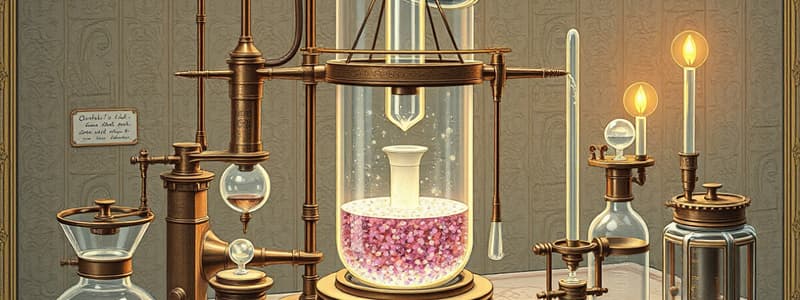Podcast
Questions and Answers
What is the primary function of a centrifuge?
What is the primary function of a centrifuge?
- To mix different substances uniformly
- To separate solid material from liquid suspension (correct)
- To measure the density of liquids
- To heat liquids to high temperatures
What principle does a centrifuge operate on?
What principle does a centrifuge operate on?
- Evaporation principle
- Filtration principle
- Condensation principle
- Sedimentation principle (correct)
Which three variables are crucial for determining centrifugal force in a centrifuge?
Which three variables are crucial for determining centrifugal force in a centrifuge?
- Time, energy, and flow rate
- Mass, speed, and radius (correct)
- Temperature, volume, and speed
- Density, pressure, and area
What happens to blood cells when a centrifuge is used on blood?
What happens to blood cells when a centrifuge is used on blood?
What component of a centrifuge holds the samples during operation?
What component of a centrifuge holds the samples during operation?
What is the primary purpose of a hematocrit centrifuge?
What is the primary purpose of a hematocrit centrifuge?
Which of the following conditions can be assessed using a hematocrit centrifuge?
Which of the following conditions can be assessed using a hematocrit centrifuge?
Which feature distinguishes a benchtop centrifuge from larger types of centrifuges?
Which feature distinguishes a benchtop centrifuge from larger types of centrifuges?
How does a benchtop centrifuge generate centrifugal force?
How does a benchtop centrifuge generate centrifugal force?
What is the maximum speed that a micro hematocrit centrifuge can reach?
What is the maximum speed that a micro hematocrit centrifuge can reach?
What type of motor powers a benchtop centrifuge?
What type of motor powers a benchtop centrifuge?
What component does a hematocrit centrifuge use that is similar to a benchtop centrifuge?
What component does a hematocrit centrifuge use that is similar to a benchtop centrifuge?
What is the RCF capability of a micro hematocrit centrifuge?
What is the RCF capability of a micro hematocrit centrifuge?
What is the maximum speed range for low-speed centrifuges?
What is the maximum speed range for low-speed centrifuges?
Which type of centrifuge would be best suited for separating DNA and organelles in cells?
Which type of centrifuge would be best suited for separating DNA and organelles in cells?
At what speed range does a high-speed centrifuge typically operate?
At what speed range does a high-speed centrifuge typically operate?
What is the primary use of an ultracentrifuge?
What is the primary use of an ultracentrifuge?
Which centrifuge is primarily used for biochemical applications that require fast operation?
Which centrifuge is primarily used for biochemical applications that require fast operation?
How does a micro centrifuge typically preform its separation?
How does a micro centrifuge typically preform its separation?
What safety feature is mentioned for centrifuges?
What safety feature is mentioned for centrifuges?
Which option best describes the primary function of low-speed centrifuges?
Which option best describes the primary function of low-speed centrifuges?
What component of an autoclave ensures that high pressures are maintained during operation?
What component of an autoclave ensures that high pressures are maintained during operation?
Which of the following steps is NOT part of the method of operation for using an autoclave?
Which of the following steps is NOT part of the method of operation for using an autoclave?
What is the purpose of the basket in an autoclave?
What is the purpose of the basket in an autoclave?
Which item is NOT typically sterilized using an autoclave?
Which item is NOT typically sterilized using an autoclave?
What function does the tare option on an electronic balance perform?
What function does the tare option on an electronic balance perform?
What type of water should be used in an autoclave?
What type of water should be used in an autoclave?
What role does the electrical heater serve in an autoclave?
What role does the electrical heater serve in an autoclave?
Which of the following best describes the design purpose of a safety valve in an autoclave?
Which of the following best describes the design purpose of a safety valve in an autoclave?
What is the primary method used by an autoclave for sterilization?
What is the primary method used by an autoclave for sterilization?
What is the typical temperature and time for sterilization in an autoclave?
What is the typical temperature and time for sterilization in an autoclave?
Which combination is essential for the functioning of an autoclave?
Which combination is essential for the functioning of an autoclave?
What role does pressure play in an autoclave's sterilization process?
What role does pressure play in an autoclave's sterilization process?
What is the risk associated with using an autoclave?
What is the risk associated with using an autoclave?
What primarily kills microorganisms in the autoclave process?
What primarily kills microorganisms in the autoclave process?
How does the relationship between pressure and temperature affect the sterilization process?
How does the relationship between pressure and temperature affect the sterilization process?
Which of the following materials can be sterilized using an autoclave?
Which of the following materials can be sterilized using an autoclave?
Flashcards are hidden until you start studying
Study Notes
Centrifuge
- Separates solid materials from liquid suspensions using centrifugal force.
- Samples are placed in special glass or plastic tubes of various sizes.
- Operates on the principle of sedimentation, where denser substances settle at the bottom.
- The centrifugal force relies on three variables: mass, speed, and radius.
- More dense materials are forced against the walls of the tubes, separating from fluids.
Components of a Centrifuge
- Electric motor drives the spinning head that carries samples.
- Safety shield is crucial, equipped with a micro switch that cuts power when the lid is opened.
- Advanced models may include displays and keyboards for programming speeds.
Types of Centrifuges
- Low-Speed Centrifuge:
- Operates at 4000-5000 rpm, commonly used for regular particle sorting.
- High-Speed Centrifuge:
- Speeds range from 15,000 to 30,000 rpm, ideal for biochemical applications requiring fast processing.
- Ultracentrifuges:
- Operate at extremely high speeds, perfect for separating smaller molecules like proteins and viruses.
- Micro Centrifuges:
- Designed for small volumes (0.5-2 µl), usually spin at 12,000-13,000 rpm for cellular organelle separation.
- Hematocrit Centrifuge:
- Determines erythrocyte volume fraction in blood samples, operates around 11,000 rpm, useful for various medical tests.
- Benchtop Centrifuge:
- Compact, powered by electric motors, versatile for small laboratory spaces, operates tubes around an undetermined axis.
Autoclave
- Device for sterilizing equipment and materials using high-pressure saturated steam at 121 °C for 15-20 minutes.
- Common sterilization methods include wet heat, dry heat, chemicals, and radiation.
- Operates on the principles of steam combined with pressure and time to inactivate microorganisms and spores.
Autoclave Principles
- Sterilization relies on the heat of pressurized steam, which can exceed normal boiling temperatures (2.2 bar at 134 °C).
- Pressure and temperature are directly proportional; steam allows temperatures to rise, effectively killing microorganisms.
Construction of Autoclaves
- Made from strong metal jackets to withstand high pressure.
- Features include hermetically sealed doors, pressure gauges, safety valves, thermometers, and electrical heaters.
- Commonly used in microbiology, medicine, dentistry, and for sterilizing lab glassware and surgical instruments.
Autoclave Operation Method
- Fill with distilled water without exceeding the basket’s bottom.
- Place materials in the basket, close and seal the lid.
- Adjust settings for temperature, pressure, and time before starting the sterilization cycle.
Balance
- Essential lab instrument for measuring chemicals, media, or laboratory animals.
- Using an Electronic Balance:
- Place a clean container on the pan, then use the tare function to zero the displayed weight before measurement.
Studying That Suits You
Use AI to generate personalized quizzes and flashcards to suit your learning preferences.




